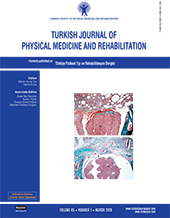Evaluation of the effects of neural therapy in patients diagnosed with fibromyalgia
2 Department of Physical Therapy and Rehabilitation, Kocaeli Derince Training and Research Hospital, Kocaeli, Turkey
3 Department of Physical Therapy and Rehabilitation, Special Özlem Physical Therapy and Rehabilitation Center, Konya, Turkey
4 Department of Physical Therapy and Rehabilitation, Bezmialem Foundation University, İstanbul, Turkey
5 Department of Physical Therapy and Rehabilitation, Beyhekim State Hospital, Konya, Turkey DOI : 10.5606/tftrd.2019.1931 Objectives: This study aims to compare the effects of neural therapy and exercise on pain, quality of life, depression, anxiety, and functioning status in patients diagnosed with fibromyalgia syndrome (FMS).
Patients and methods: This multi-center study included a total of 72 patients (60 females, 12 males; mean age: 39.2±9.5 years; range, 22 to 53 years) who were diagnosed with FMS according to the 1990 American College of Rheumatology (ACR) criteria between January 2015 and June 2015. The patients were randomly divided into two groups: the first group (n=30) received an exercise program (strengthening, stretching, relaxation, and aerobic exercises, three days a week), and the second group (n=42) received a total of six sessions of neural therapy as one session a week in addition to the same exercise program. Pain severity was assessed with the Visual Analog Scale (VAS), emotional state with the Beck Depression Scale (BDS) and Beck Anxiety Inventory (BAI), quality of life with Short Form-36 (SF-36), and functioning status with the Fibromyalgia Impact Questionnaire (FIQ). The patients were evaluated at the end of treatment (week 6) and one month after the end of treatment.
Results: The mean disease duration was 34.3±9.3 months, the mean VAS score was 7.3±2.2, and the mean FIQ score was 58.4±13.2. There were significant improvements in the VAS, FIQ, SF-36, BDS, and BAI scores after the treatment in both groups (p<0.05). Post-treatment BDS and VAS scores were significantly lower in the neural therapy group (p=0.038; p=0.049; p<0.05). There was no significant difference in any parameter one month after the treatment between the groups (p>0.05).
Conclusion: When neural therapy is combined with exercise in FMS patients, it may be advantageous in terms of pain and depression, compared to exercise alone.
Keywords : Fibromyalgia, lidocaine, neural therapy

















